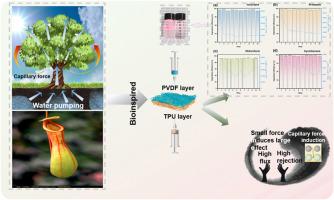An adaptive and fast emulsion separation Janus membrane
IF 7.1
3区 材料科学
Q1 GREEN & SUSTAINABLE SCIENCE & TECHNOLOGY
引用次数: 0
Abstract
Inspired by the capillary effect in nature (such as water transport in soils) and droplet-drive performance of Nepenthes, a new driving strategy for emulsion separation membrane based on the synergistic effect of capillary force and progressive wettability-induction force was proposed. It is prepared by a one-step, simple continuous, electrospinning process. By adjusting solutions and spinning parameters, the membrane obtains its capillary structure and progressive oleophilicity in one-step preparation. Attractively, the membrane shows separation efficiency and excellent permeability, with a flux of 384801 L m−2 h−1 bar−1 for the oil-water mixture, and the little water content of less than 18 ppm. And for emulsions, the flux even reaches 50000 L m−2 h−1 bar−1 and the separation efficiency reaches 99.95%. Furthermore, the membrane has excellent mechanical-stability: at 80 kPa transmembrane pressure, it can still effectively prevent water's penetration. Drawing inspiration from nature, the incorporation of capillary force and progressive wettability-induction force into the separation membrane as an additional dual emulsion separation driving force proves to be a highly effective and versatile approach. This method provides a way to solve the general flux-efficiency balance problem of oil-water separation and also provides a new strategy for the preparation of separation membranes for various purposes.

自适应快速乳液分离 Janus 膜
受自然界中的毛细管效应(如土壤中的水输送)和尼泊金的液滴驱动性能的启发,提出了一种基于毛细管力和渐进润湿诱导力协同效应的乳液分离膜的新驱动策略。它是通过一步式、简单连续的电纺丝工艺制备的。通过调整溶液和纺丝参数,该膜在一步制备过程中获得了毛细管结构和渐进亲油性。该膜具有极高的分离效率和极佳的渗透性,对油水混合物的通量可达 384801 L m-2 h-1 bar-1,且含水量小于 18 ppm。对于乳状液,通量甚至达到 50000 L m-2 h-1 bar-1,分离效率达到 99.95%。此外,该膜还具有出色的机械稳定性:在 80 kPa 的跨膜压力下,它仍能有效阻止水的渗透。从大自然中汲取灵感,在分离膜中加入毛细管力和渐进润湿诱导力作为额外的双重乳液分离驱动力,被证明是一种高效且多用途的方法。这种方法为解决油水分离的一般通量-效率平衡问题提供了一种途径,也为制备各种用途的分离膜提供了一种新策略。
本文章由计算机程序翻译,如有差异,请以英文原文为准。
求助全文
约1分钟内获得全文
求助全文
来源期刊

Materials Today Sustainability
Multiple-
CiteScore
5.80
自引率
6.40%
发文量
174
审稿时长
32 days
期刊介绍:
Materials Today Sustainability is a multi-disciplinary journal covering all aspects of sustainability through materials science.
With a rapidly increasing population with growing demands, materials science has emerged as a critical discipline toward protecting of the environment and ensuring the long term survival of future generations.
 求助内容:
求助内容: 应助结果提醒方式:
应助结果提醒方式:


